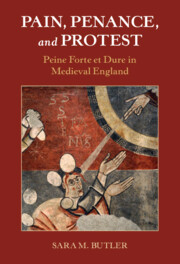34 results
Elizabeth Allen. Uncertain Refuge: Sanctuary in the Literature of Medieval England. The Middle Ages Series. Philadelphia: University of Pennsylvania Press, 2021. Pp. 311. $59.95 (cloth).
-
- Journal:
- Journal of British Studies / Volume 62 / Issue 4 / October 2023
- Published online by Cambridge University Press:
- 19 February 2024, pp. 1043-1044
- Print publication:
- October 2023
-
- Article
- Export citation
Attitudes to Domestic Violence in Christian Europe
-
-
- Book:
- A Companion to Crime and Deviance in the Middle Ages
- Published by:
- Amsterdam University Press
- Published online:
- 14 February 2024
- Print publication:
- 30 June 2023, pp 397-414
-
- Chapter
- Export citation
Marriage Litigation in the Western Church, 1215–1517. By Wolfgang P. Müller. Cambridge: Cambridge University Press, 2021. v + 270 pp. $99.99 hardcover.
-
- Journal:
- Church History / Volume 91 / Issue 3 / September 2022
- Published online by Cambridge University Press:
- 16 December 2022, pp. 669-671
- Print publication:
- September 2022
-
- Article
- Export citation
4 - Peine Forte et Dure as Barbarity? Putting the Practice in Context
-
- Book:
- Pain, Penance, and Protest
- Published online:
- 19 November 2021
- Print publication:
- 18 November 2021, pp 188-249
-
- Chapter
- Export citation
Acknowledgments
-
- Book:
- Pain, Penance, and Protest
- Published online:
- 19 November 2021
- Print publication:
- 18 November 2021, pp ix-x
-
- Chapter
- Export citation
7 - Rejecting the Jury, Rejecting the Common Law, Rejecting the King
-
- Book:
- Pain, Penance, and Protest
- Published online:
- 19 November 2021
- Print publication:
- 18 November 2021, pp 348-397
-
- Chapter
- Export citation
Conclusion
-
- Book:
- Pain, Penance, and Protest
- Published online:
- 19 November 2021
- Print publication:
- 18 November 2021, pp 398-415
-
- Chapter
- Export citation
6 - Standing Mute as Imitatio Christi
-
- Book:
- Pain, Penance, and Protest
- Published online:
- 19 November 2021
- Print publication:
- 18 November 2021, pp 303-347
-
- Chapter
- Export citation
Bibliography
-
- Book:
- Pain, Penance, and Protest
- Published online:
- 19 November 2021
- Print publication:
- 18 November 2021, pp 416-447
-
- Chapter
- Export citation
Table of Statutes
-
- Book:
- Pain, Penance, and Protest
- Published online:
- 19 November 2021
- Print publication:
- 18 November 2021, pp xi-xii
-
- Chapter
- Export citation
Abbreviations
-
- Book:
- Pain, Penance, and Protest
- Published online:
- 19 November 2021
- Print publication:
- 18 November 2021, pp xiii-xiv
-
- Chapter
- Export citation
3 - Due Process and Consent to Jury Trial
-
- Book:
- Pain, Penance, and Protest
- Published online:
- 19 November 2021
- Print publication:
- 18 November 2021, pp 134-187
-
- Chapter
- Export citation
1 - Peine Forte et Dure: The Medieval Practice
-
- Book:
- Pain, Penance, and Protest
- Published online:
- 19 November 2021
- Print publication:
- 18 November 2021, pp 26-79
-
- Chapter
- Export citation
Index
-
- Book:
- Pain, Penance, and Protest
- Published online:
- 19 November 2021
- Print publication:
- 18 November 2021, pp 448-474
-
- Chapter
- Export citation
5 - Why Stand Mute?
-
- Book:
- Pain, Penance, and Protest
- Published online:
- 19 November 2021
- Print publication:
- 18 November 2021, pp 250-302
-
- Chapter
- Export citation
Contents
-
- Book:
- Pain, Penance, and Protest
- Published online:
- 19 November 2021
- Print publication:
- 18 November 2021, pp vii-vii
-
- Chapter
- Export citation
Introduction
-
- Book:
- Pain, Penance, and Protest
- Published online:
- 19 November 2021
- Print publication:
- 18 November 2021, pp 1-25
-
- Chapter
- Export citation
Copyright page
-
- Book:
- Pain, Penance, and Protest
- Published online:
- 19 November 2021
- Print publication:
- 18 November 2021, pp vi-vi
-
- Chapter
- Export citation
Tables
-
- Book:
- Pain, Penance, and Protest
- Published online:
- 19 November 2021
- Print publication:
- 18 November 2021, pp viii-viii
-
- Chapter
- Export citation

Pain, Penance, and Protest
- Peine Forte et Dure in Medieval England
-
- Published online:
- 19 November 2021
- Print publication:
- 18 November 2021



